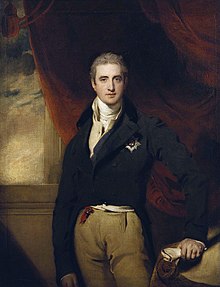
Robert Stewart, 2nd Marquess of Londonderry,, usually known as Lord Castlereagh, derived from the courtesy title Viscount Castlereagh by which he was styled from 1796 to 1821, was a British statesman and politician. As secretary to the Viceroy of Ireland, he worked to suppress the Rebellion of 1798 and to secure passage in 1800 of the Irish Act of Union. As the Foreign Secretary of the United Kingdom from 1812, he was central to the management of the coalition that defeated Napoleon, and was British plenipotentiary at the Congress of Vienna. In the post-war government of Lord Liverpool, Castlereagh was seen to support harsh measures against agitation for reform. He killed himself while in office in 1822.
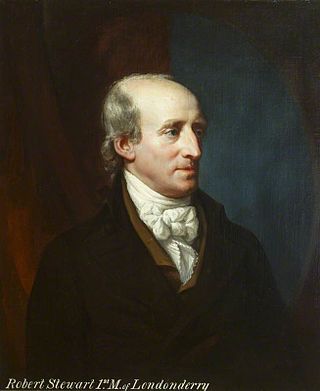
Robert Stewart, 1st Marquess of LondonderryPC (Ire) (1739–1821), was a County Down landowner, Irish Volunteer, and member of the parliament who, exceptionally for an Ulster Scot and Presbyterian, rose within the ranks of Ireland's "Anglican Ascendancy." His success was fuelled by wealth acquired through judicious marriages, and by the advancing political career of his son, Viscount Castlereagh. In 1798 he gained notoriety for refusing to intercede on behalf of James Porter, his local Presbyterian minister, executed outside the Stewart demesne as a rebel.

Marquess Conyngham, of the County of Donegal, is a title in the Peerage of Ireland. It was created in 1816 for Henry Conyngham, 1st Earl Conyngham. He was the great-nephew of another Henry Conyngham, 1st Earl Conyngham, a member of a family of Scottish descent which had settled during the Plantation of Ulster in County Donegal in Ireland in the early 17th century. The 'founder' of the dynasty in Ireland was The Very Rev. Dr. Alexander Cunningham, Dean of Raphoe. The earlier Henry was a member of both the Irish House of Commons and the British House of Commons and served as Vice-Admiral of Ulster and as Governor of the counties of Donegal and Londonderry. In 1753 he was raised to the Peerage of Ireland as Baron Conyngham, of Mount Charles in the County of Donegal, and in 1756 he was created Viscount Conyngham, in Ireland, also in the Peerage of Ireland. In 1781 he was made Baron Conyngham, of Mount Charles in the County of Donegal, with remainder to his nephew Francis Burton, and Earl Conyngham, of Mount Charles in the County of Donegal, which like the creations of 1753 and 1756 was created with normal remainder to the heirs male of his body. The latter titles were also in the Peerage of Ireland. Lord Conyngham was childless and on his death in 1781 the barony of 1753, the viscountcy and earldom became extinct while he was succeeded in the barony of 1781 according to the special remainder by his aforementioned nephew Francis. He was the eldest son of Mary, sister of the first Earl Conyngham, by her husband Francis Burton. The new 2nd Baron Conyngham, who had earlier represented Killybegs and County Clare in the Irish House of Commons, assumed by Royal licence the surname and arms of Conyngham on succeeding to the titles.
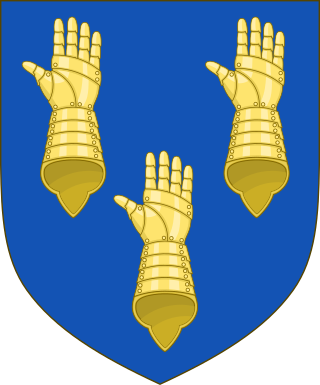
Baron Barnard, of Barnard Castle in the Bishopric of Durham, is a title in the Peerage of England. It was created in 1698 for Christopher Vane, who had previously served as a member of parliament for County Durham and Boroughbridge. Vane was the son of Sir Henry Vane the Younger and grandson of Sir Henry Vane the Elder. His grandson, the third Baron, notably served as Paymaster of the Forces and as Lord Lieutenant of County Durham. In 1754 he was created Viscount Barnard and Earl of Darlington, both in the County Palatine of Durham. Lord Darlington was the husband of Lady Grace FitzRoy, daughter of Charles FitzRoy, 2nd Duke of Cleveland, the illegitimate son of King Charles II by his mistress Barbara Villiers, 1st Duchess of Cleveland.

Earl of Antrim is a title that has been created twice, both times in the Peerage of Ireland and both times for members of the MacDonnell family, originally of Scottish origins.
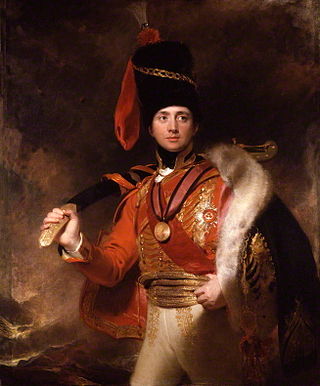
Charles William Vane, 3rd Marquess of Londonderry, was an Anglo-Irish nobleman, a British soldier and a politician. He served in the French Revolutionary Wars, in the suppression of the Irish Rebellion of 1798, and in the Napoleonic wars. He excelled as a cavalry commander in the Peninsular War (1807–1814) under John Moore and Arthur Wellesley.

Charles Stewart Henry Vane-Tempest-Stewart, 7th Marquess of Londonderry,, styled Lord Stewart until 1884 and Viscount Castlereagh between 1884 and 1915, was a British peer and politician. He is best remembered for his tenure as Secretary of State for Air in the 1930s and for his attempts to reach an understanding with Nazi Germany. In 1935 he was removed from the Air Ministry but retained in the Cabinet as Lord Privy Seal and Leader of the House of Lords.

Frederick William Robert Stewart, 4th Marquess of Londonderry (1805–1872), styled Viscount Castlereagh from 1822 to 1854, was a British nobleman and Tory politician. He was briefly Vice-Chamberlain of the Household under Sir Robert Peel between December 1834 and April 1835.
Edward Charles Stewart Robert Vane-Tempest-Stewart, 8th Marquess of Londonderry,, styled Lord Stewart until 1915 and Viscount Castlereagh between 1915 and 1946, was a British peer and politician.

Mount Stewart is a 19th-century house and garden in County Down, Northern Ireland, owned by the National Trust. Situated on the east shore of Strangford Lough, a few miles outside the town of Newtownards and near Greyabbey, it was the Irish seat of the Stewart family, Marquesses of Londonderry. Prominently associated with the 2nd Marquess, Robert Stewart, Viscount Castlereagh, Britain's Foreign Secretary at the Congress of Vienna and with the 7th Marquess, Charles Vane-Tempest-Stewart, the former Air Minister who at Mount Stewart attempted private diplomacy with Hitler's Germany, the house and its contents reflect the history of the family's leading role in social and political life in Britain and Ireland.

George Henry Robert Charles William Vane-Tempest, 5th Marquess of Londonderry, KP, styled Viscount Seaham between 1823 and 1854 and known as The Earl Vane between 1854 and 1872, was a British aristocrat, businessman, diplomat and Conservative politician.

Seaham Hall is an English country house, now run as a spa hotel, in County Durham.
Alexander Charles Robert "Alastair" Vane-Tempest-Stewart, 9th Marquess of Londonderry was a British nobleman.
Lord Adolphus Frederick Charles William Vane-Tempest, known until 1854 as Lord Adolphus Vane, was a Conservative Party politician in the United Kingdom.
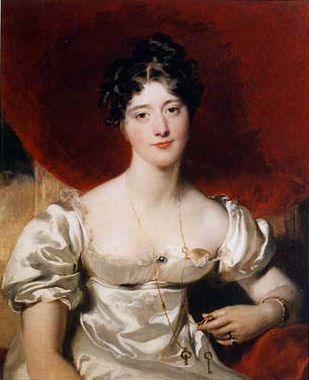
Frances Anne Vane, Marchioness of Londonderry was a wealthy Anglo-Irish heiress and noblewoman. She was the daughter of Sir Henry Vane-Tempest, 2nd Baronet. She married Charles William Stewart, 1st Baron Stewart. She became a marchioness in 1822 when Charles succeeded his half-brother as 3rd Marquess of Londonderry.

Charles Stewart Vane-Tempest-Stewart, 6th Marquess of Londonderry,, styled Viscount Castlereagh between 1872 and 1884, was a British Conservative politician, landowner and benefactor, who served in various capacities in the Conservative administrations of the late 19th and early 20th centuries. After succeeding his father in the marquessate in 1884, he was Lord-Lieutenant of Ireland between 1886 and 1889. He later held office as Postmaster General between 1900 and 1902 and as President of the Board of Education between 1902 and 1905. A supporter of the Protestant causes in Ulster, he was an opponent of Irish Home Rule and one of the instigators of the formal alliance between the Conservative Party and the Liberal Unionists in 1893.

The Vane, later Vane-Tempest Baronetcy, of Long Newton in the County of Durham, was a title in the Baronetage of Great Britain. The Vane baronetcy was created on 13 July 1782 for Reverend Henry Vane, D.D., second son of George Vane of Long Newton. He was a descendant of Sir Henry Vane the Elder. Vane married Frances Tempest, daughter of John Tempest of Sherburne, Durham. When her brother, John Tempest Sr., died in 1771 naming the baronet's son as his heir, the younger Vane assumed by Royal licence the additional surname of Tempest in accordance with his uncle's will. Thus, when the 1st baronet died in 1794, his son became Baronet Vane-Tempest. This second baronet represented both the city and county of Durham in Parliament and was a well-known sportsman. He married Anne MacDonnell, 2nd Countess of Antrim. They had one child Lady Frances Anne, who married Lord Charles Stewart, later 3rd Marquess of Londonderry, who assumed the surname of Vane and in 1823 was named Earl Vane and Viscount Seaham. When Vane-Tempest died in 1813, the baronetcy became extinct.
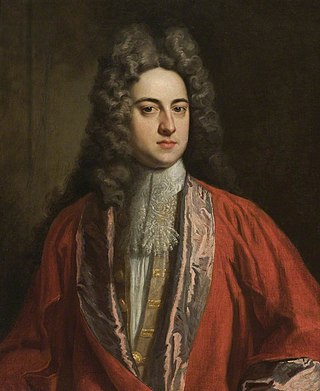
Alexander Stewart (1699–1781) was an Irish landowner who grew rich by inheriting a fortune from Robert Cowan, a former governor of Bombay. His son Robert became the 1st Marquess of Londonderry.
The Custos Rotulorum of Londonderry and Down was the highest civil officer in counties Londonderry and Down.

Theresa Susey Helen Vane-Tempest-Stewart, Marchioness of Londonderry was a British socialite and political hostess. She was a leading Unionist campaigner against Irish Home Rule, serving as president of the Ulster Women's Unionist Council from 1913 to 1919. She was said to be one of the most "dominating feminine personalities" of the time and was referred to as the "Queen of Toryism" and a "highwaywoman in a tiara."


